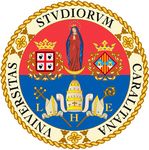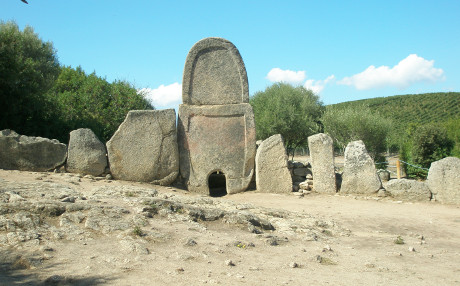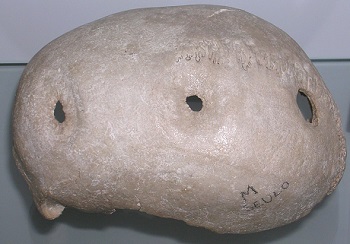Itinerary edited by the UNIVERSITY OF CAGLIARI 

The museums hosting collections of biological anthropology are rarely among the places most visited by tourists. The Sardinian Museum of Anthropology and Ethnography is a small and unusual university museum that has become a favourite for school trips. It is also visited by many people interested in biological anthropology, human palaeontology and evolution, and Sardinian ethnography as well as many aspects of human skeletal anatomy. The museum holdings cover the whole island, including its diverse range of natural environments, such as the valleys in the Campidano area that stretch between Oristano and Cagliari, the inland mountain systems and the Sardinian coastline.
Some archaeological sites dating back to the proto-historic age
The Necropolis of Li Muri and the Li Longi Giant’s Tomb (Arzachena, Province of Sassari).


 An archaeological find:
An archaeological find: The Seulo Skull (Perforated Skull)
Origin: Seulo (CA)Origin: Seulo (CA)
Period: Nuragic Age - Dating approx. C14: 3470+/-60 B.P.
Held by: Sardinian Museum of Anthropology and Ethnography - UNICA - Series: SEULO - Cannisoni e Gastea - find M; internal catalogue no.: MSAE 7640
Age: mature adult; Gender: male;
etail: Skullcap with three perforations on the left-hand side
 The first Homo sapiens of Sardinia
The first Homo sapiens of SardiniaThe collections are arranged to reflect the personality of Carlo Maxia, the founder of the Sardinian Museum of Anthropology and Ethnography. His aim was to study the Sardinian population starting from its prehistory. To do so, he analysed the population according to the geographical and cultural context they lived in. The first question he tried to answer concerned the first “ Homo ” species to reach and subsequently settle in Sardinia.
Currently, some scholars suggest that the first human settlements (Homo sapiens) in Sardinia can be dated to the lower to middle Pleistocene era (Martini and Ulzega, 1989-90; Martini, 1999). Such a theory is supported by handmade lithic objects dating back to the archaic Clactonian period and found in the Anglona area (in the municipalities of Perfugas and Laerru). Some of these objects seem to be approximately 500,000 years old, while others belong to a more recent period, roughly 150,000 years ago. The most ancient trace of Homo sapiens in Sardinia currently dates back to the Upper Palaeolithic, as demonstrated by the finding of a proximal portion of a human hand phalanx in the Curbeddu cave (area E05, level DEF-27, Room 2), near Oliena. According to the place where the phalanx was found, some scholars determined an approximate age of 20,000 years (Sondaar et al., 1993; 1995; 1998). No handmade objects were found along with this bone so it appears impossible to establish whether its owner belonged to other continental cultures of the same period (Sondaar et al., 1993). Other findings of handmade lithic objects and skeletal bones indicate that there were human settlements in both the Upper Paleolithic and Mesolithic. From the Neolithic era onwards, the findings of many skeletal bones across the island attest to a constant human presence in Sardinia, which is further borne out by the finds dating back to the early Holocene in S’Omu e s’Orku site, in the Arbus area (Rosalba Floris et al. 2012).
The debate regarding the origin and composition of the Sardinian population seems to support the hypothesis that its diversity is due to the immigration of various small-sized groups from the Upper Palaeolithic to the Neolithic periods (Sanna, 2006, 2009; D’Amore et al., 2010).